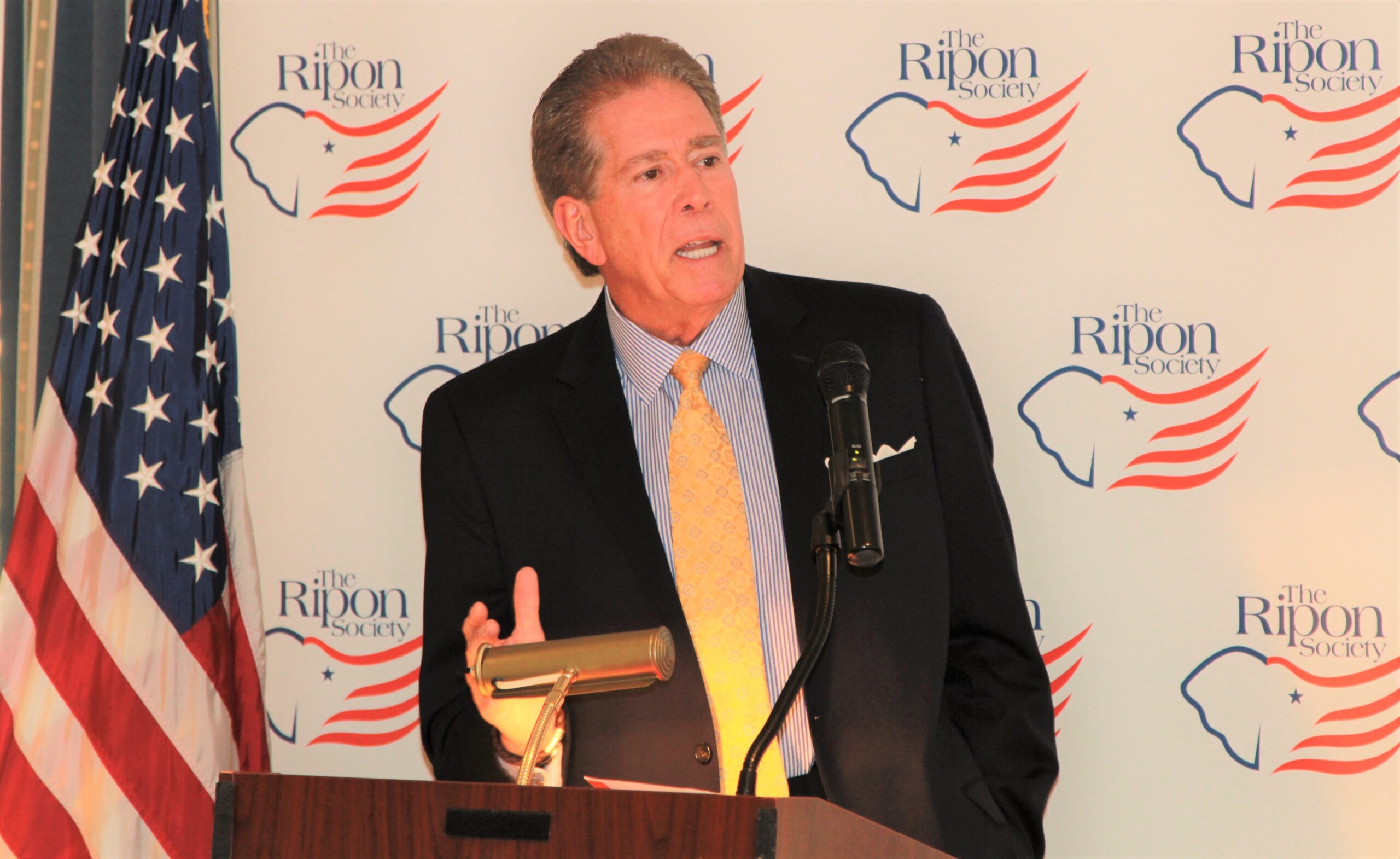 Veteran Strategist Ed Goeas Discusses Political Landscape Heading Into Next Year
Veteran Strategist Ed Goeas Discusses Political Landscape Heading Into Next Year
WASHINGTON, DC — With the 2020 election just over a year away, The Ripon Society hosted a luncheon discussion on Monday with veteran pollster, President & CEO of The Tarrance Group, Ed Goeas. Among other things, Goeas discussed the results of a recent poll he conducted on behalf of Georgetown University and what it means for next year’s election.
The poll covered a variety of topics – ranging from presidential approval to the Democratic presidential primary – but Goeas first kicked off the event by discussing what he sees as elevated political engagement amongst voters nationwide.
“We have the highest intensity for this period of time than in any election cycle we’ve ever looked at,” Goeas explained matter-of-factly. “The group of voters saying that they were extremely likely to vote in this next election was at 82%. It usually hovers in the high 60s to low 70s around this point of time and grows to about 75% by the election. We’re already way past that.
“The other thing that was a surprise is Republicans are more intense than Democrats at this point, more intense by two percentage points with 84%, 82% for the Democrats. But, independents, which are usually way down at this point in the campaign, are at 79%. They’re right up there with Republicans and Democrats. That’s going to mean it’s going to be much more difficult to predict movement and analyze movement going forward.”
Goeas then turned to President Trump’s job approval rating, where his poll found that 43% of voters approve of the President while 53% disapprove. He explained where he sees the most support for the President.
“Trump has his 33% base, and then he has another 12% – mainly Republicans that dislike his style and character but like his policies and choose to put a premium on the policies. Part of what has happened with that group since the election is really two things: one is the tax bill going through had a huge impact with locking those Republicans in, which is why his job approval now is combining that 33% and that 12% and he’s hovering in the mid-40s on his job approval. The other thing is that the Democrats have been acting just as uncivil in terms of the environment out there.”
“The bad news for Trump is that there is another 12% that like his policies but don’t like his character and put a priority on the character. They tend to be suburban, white, married, women who used to consider themselves to be Republican, and they are independents and conservative Democrats.”
The Tax Cuts and Jobs Act has turned out to be a key factor heading into the next election, according to Goeas, due to its overall economic impact and especially its direct effect on the American middle class. But, he is concerned the messaging surrounding the accomplishment is not as clear and effective as it should be.
“On taxes, his job approval is actually upside down by 2 points, 49% disapprove, and 47% approve.”
“Quite frankly, so many of our broader group of voters in the Republican Party are not owners of big business, they’re owners or employees of small businesses across the country. That’s what we should be selling on the tax bill, what we did for middle class and small business. I think this is a sign that the President is not quite getting there on selling the message of middle class tax cuts and small business tax cuts.”
Why are middle class voters so important? Goeas explains that this slice of the electorate is crucial because it is not only the largest segment of the population, but it is also the only socioeconomic class where the President currently has an edge.
“Upper income tends to be at 8% of the electorate. Working class… really only runs about 10 or 12%, and 58% of the electorate says that they are middle class. They consider themselves to be middle class. It was always the argument I made in campaigns: talk middle class. They consider themselves to be middle class, not some demographer that defines middle classes within a certain income level.
“Today, Trump is only leading on the ballot with one group and that’s the middle class. The group that is actually worst against him is high income, not low income.”
The discussion then moved to the tone of the upcoming campaign. Goeas pointed to the 2016 campaign’s level of negativity as an example of what to expect this next time around, and revealed that the data already backs that up when it comes to its effect on the Democratic candidates.
“What I’m seeing in all the candidates, when we tested them, is only one was right side up with higher favorables than unfavorable, and that was Mayor Pete. He was only up by three points.”
From what he can tell from the polls, the Democratic candidates for president all garner a higher “strongly disapprove” rate among voters than what would be expected this early in the campaign, indicating an even more partisan environment in 2020.
“You have that Trump base that as soon as they come aware of the person who is a candidate, a potential candidate against Trump, they immediately shift over to a position of strongly disapprove, which I think is going to make the job a little bit better for Trump. But, what it means for all of us is we’re going to see another nasty, dirty, negative campaign in 2020, and I think it’s unfortunate for the country when we have so many good things we could be talking about that we have done well. There are so many things that we have better solutions for than the Democrats, but they’re not going to hear any of it. It’s going to be lost.
“My bigger concern is, and I know you’ve heard differently perhaps last week, I don’t think there is a chance that we win back control of the House. I think our target, quite frankly, is that we don’t get the hole dug any deeper for us in this election in the House, so that when it swings back in our direction we are in a better position than where we were when I was at the [NRCC] and we were digging out such a deep hole from Watergate. My biggest concern is that the Senate is going to be exactly what we’re kind of hearing. It’s going to be a very, very tough campaign shadowed under this negative campaign with a lot of animosity towards our president of our party. That is going to make those races even tougher.”
Finally, Goeas was asked about the outlook of the Democratic primary. More specifically, he was asked about former Vice President Joe Biden and U.S. Sen. Elizabeth Warren (MA) and whether President Trump would prefer a general election match-up with Warren.
“I think he does. Look, Biden is the toughest opponent by far. He has a much deeper image out there, and yes the negative stuff comes up, but it’s not nearly as bad as his strongly favorables.”
“Mayor Pete is getting very interesting results out there. For a lot of those Republicans who liked Trump policies but don’t like his character, what little bit they’ve seen of [Buttigieg], they believe he comes across as fairly conservative, he comes across as fairly middle-class and mainstream, and he absolutely doesn’t smell like a politician in the way he approaches things. So he would be very interesting for the Democrats from an acceptability in the general election perspective. But, right now I think the fight is between Biden and Warren. And the question is if the Sanders vote ever collapses, Warren goes from below to even ahead of Biden.”
To view Goeas’ remarks before The Ripon Society discussion on Monday, please click on the link below:
The Ripon Society is a public policy organization that was founded in 1962 and takes its name from the town where the Republican Party was born in 1854 — Ripon, Wisconsin. One of the main goals of The Ripon Society is to promote the ideas and principles that have made America great and contributed to the GOP’s success. These ideas include keeping our nation secure, keeping taxes low and having a federal government that is smaller, smarter and more accountable to the people.



